Alocasia plants are loved for indoor gardens. They have over 80 species. To make them look their best, you need to care for them right.
These plants can grow really tall in the wild. But, they usually stay 1-2 feet tall indoors. This is if you take good care of them.
To keep your Alocasia happy, you need to give it the right things. This includes light, water, and food. If you do this, your Alocasia will be beautiful. Plus, it can help clean the air in your home.
Introduction to Alocasia
Alocasia, also called elephant ear, has big, ear-shaped leaves. It’s a type of plant in the Arum family. There are over 90 kinds of Alocasia plants. They come in different sizes, shapes, and colors, making them great for indoor gardens.
To take good care of Alocasia, you need to know about each type. And how to care for them in general.
For Alocasia care, the right environment is key. They like bright, indirect light and lots of moisture. But, too much water can cause root rot. So, finding the right balance is important.
By following the right Alocasia care tips, you can enjoy these plants at home.
What is Alocasia?
Alocasia plants come from tropical Asia and Australia. They have big, heart-shaped or arrow-shaped leaves. These leaves can be 12 to 36 inches long.
In the wild, Alocasia plants can grow up to 10 feet tall. But, indoor plants usually stay a few feet high.
Popular Alocasia Varieties
Some favorite Alocasia varieties include the A. macrorrhizos ‘Stingray’. It can grow 3 to 5 feet tall. The Alocasia ‘Reginula’ is loved for its silver-green leaves.
Choosing the right variety and following good care tips can make your home beautiful with these plants.
| Species | Leaf Color | Height |
|---|---|---|
| A. macrorrhizos ‘Stingray’ | Green with yellow veins | 3-5 feet |
| Alocasia ‘Reginula’ | Silver-green | 2-3 feet |
Ideal Growing Conditions
To make your Alocasia happy, you need to know what it likes. It loves bright, indirect light. Direct sun can hurt its leaves. So, give it filtered or dappled light instead.
Alocasia likes warm temperatures, between 60 to 85 degrees F. This makes it perfect for indoor plants.
Choosing the right soil is key. It should drain well to avoid root rot. The best soil pH is 5.5 to 6.5. You can mix peat moss, perlite, and vermiculite to make it.
High humidity is also important. Alocasia likes a humid environment, 50-70%. Use a humidifier or a tray with water and pebbles to keep it humid.
Light Requirements
Different Alocasia types need different light. Big ones can handle direct sun, but others prefer bright indirect light. Place it near an east- or west-facing window for the right light.
Temperature and Humidity Needs
Alocasia likes warm temperatures and high humidity. Keep it away from heating vents and air conditioning. Use a thermometer to check the temperature and adjust it if needed.
Soil Recommendations
The soil should drain well and be rich in organic matter. Mix peat moss, perlite, and vermiculite for the best soil. The pH should be 5.5 to 6.5. Don’t use regular potting soil, as it holds too much water.
Give your Alocasia the right light, temperature, humidity, and soil. This will help it thrive and show off its beautiful leaves.
| Factor | Ideal Condition |
|---|---|
| Light | Bright, indirect light |
| Temperature | 60-85 degrees F |
| Humidity | 50-70% |
| Soil | Well-draining, pH 5.5-6.5 |
Watering Guidelines
Watering your Alocasia right is key. You need to keep the soil moist but not too wet. Too much water can cause root rot. Not enough water can make leaves turn yellow.
To know when to water, check the soil’s top layer. If it feels dry, it’s time to water.
Alocasia loves humid places. It grows best in tropical and subtropical areas. To keep your plant happy, make the air around it more humid. You can mist it or use a humidifier.
Watch for signs of too much or too little water:
- Droopy leaves, yellow spots, and brown edges mean too much water. This can harm your plant.
- Yellow leaves and crispy edges mean it’s too dry.
By following these tips, your Alocasia will do well. It will have beautiful, exotic leaves.
| Watering Frequency | Soil Moisture | Humidity Level |
|---|---|---|
| Water every 9 days | Keep top 2-3 inches of soil dry to the touch | Maintain high humidity (50-70%) |
Fertilization Tips
When you care for your Alocasia plant, giving it the right nutrients is key. Fertilization tips help you meet your plant’s needs without too much. A balanced, water-soluble fertilizer with a 10-10-10 N-P-K ratio is best for Alocasia plants.
Here are some fertilization tips for your Alocasia:
- Use a balanced fertilizer during the growing season (spring and summer) for optimal growth.
- Apply liquid fertilizers once a month, or use slow-release fertilizers biannually.
- Be cautious of over-fertilization, which can cause yellowing leaves, stunted growth, and brown tips.
Here’s a table to help with fertilizing:
| Fertilizer Type | Application Frequency | Precautions |
|---|---|---|
| Liquid Fertilizer | Once a month | Dilute to half-strength to prevent root burn |
| Slow-Release Fertilizer | Biannually | Keep granular fertilizers at least 6 inches away from the plant’s base |
By following these fertilization tips and watching your plant’s needs, your Alocasia will thrive. You’ll get to enjoy its stunning, exotic leaves.
Potting and Repotting
Choosing the right pot and timing is key for your Alocasia plant. Alocasia plants like to be a bit snug in their pots. They should be moved to a bigger pot in the spring when they outgrow it.
When picking a pot, make sure it has holes for water to drain. Use a mix of bark, sand, and loam for the soil. Fill the pot with soil up to a third before adding the plant’s roots. Don’t forget to add stones at the bottom for water to flow.
- Repot every 12-18 months for smaller plants and every 18-24 months for larger plants.
- Choose a new pot that is 1-2 inches larger in diameter for smaller plants and 2-4 inches larger for larger plants.
- Repot during the growing season, which typically occurs in spring or early summer.
- Inspect the roots and trim away any dead or rotting roots using clean, sterilized pruning tools.
By following these tips, you can help your Alocasia plant grow well. This ensures it stays healthy and strong.
Common Pests and Diseases
Alocasia plants can get pests and diseases like spider mites and mealybugs. It’s important to check your plant often. Look for yellow leaves, weird growth, or pests.
Some pests that can harm Alocasia plants include:
- Aphids, which can cause distortion of new growth, yellowing of leaves, and sooty mold development
- Mealybugs, which can lead to yellowing and weakening of the plant by clustering on the undersides of leaves and in leaf axils
- Spider mites, which can cause stippling and discoloration of leaves, often producing fine webbing on the plant
- Scale insects, which can weaken the plant by feeding on plant juices, appearing as small, round, waxy bumps on stems and leaves
Alocasia plants can also get diseases like root rot and powdery mildew. Keep air moving, water right, and give good growing conditions. Use insecticidal soaps and neem oil for pests. Water the top inch of soil dry before watering again.
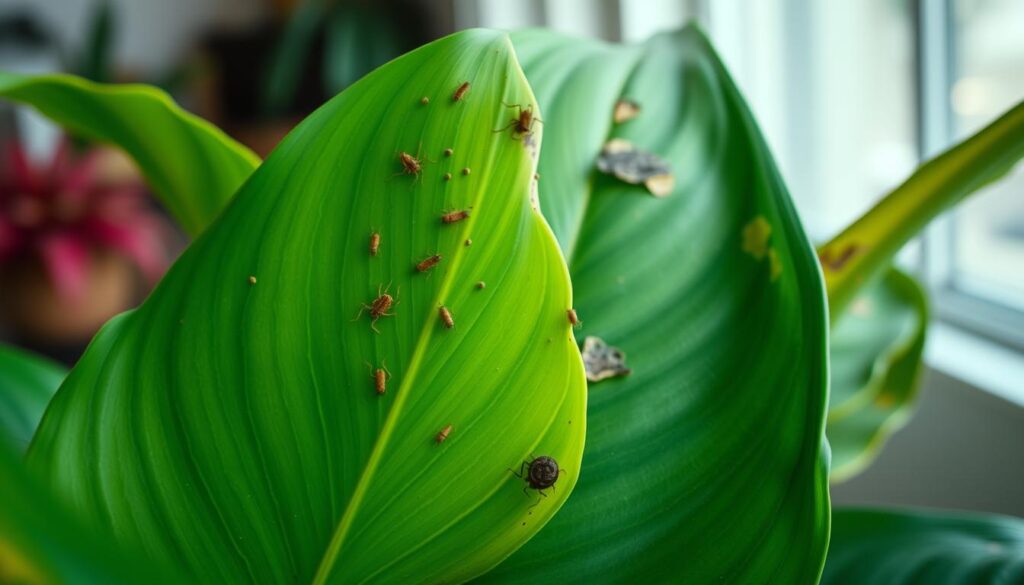
Knowing about pests and diseases helps keep your Alocasia plant healthy. Check it often and treat quickly. With care, your Alocasia will add beauty to your space.
Pruning
When you take care of your Alocasia plant, pruning is key. It helps keep the plant looking good and growing well. You can remove dead or damaged leaves to help the plant focus on growing strong.
To learn more about caring for your Alocasia, check out this complete guide.
It’s best to prune your Alocasia when it’s growing a lot, like in spring and summer. Look for yellow or damaged leaves to know when to prune. Use sharp, clean pruning shears to make cuts that heal fast.
- Prune minimally to maintain plant health
- Remove dead or damaged leaves to redirect energy to healthier parts of the plant
- Use sharp and sterile pruning shears to make clean cuts
By pruning your Alocasia often, you help it stay healthy and strong. Make sure to water and light it right after pruning to help it grow back well.
Propagation Methods
There are many ways to grow new Alocasia plants. You can use leaf cutting or division. These methods help you share plants or grow more.
Start with a healthy mother plant. For division, make sure each part has 3-5 leaves. Tubers work too, buried with the top up.
Keep the new plants humid and bright. Water them carefully. Fertilize after 8 weeks with a balanced fertilizer. This way, you can grow new Alocasia plants.
Leaf Cutting Propagation
Leaf cutting means taking a leaf from the mother plant. It needs the right care and conditions. Use moist sphagnum moss in a terrarium for best results.
Division Propagation
Division means splitting the mother plant’s roots. It’s good for plants with many stems. This way, you get new plants that will grow well.
Seasonal Care Adjustments
As the seasons change, your Alocasia plant needs seasonal care adjustments to stay healthy. In winter, it drinks less water and doesn’t need food. But in spring, it grows fast and needs more care.
For example, you can visit indoor plant care guides to learn more about caring for your Alocasia during the winter months.
Some key seasonal care adjustments to keep in mind include:
- Reducing watering frequency during winter to prevent root rot
- Increasing watering and fertilization in spring to support new growth
- Providing adequate light, but avoiding excessive light that can cause leaf burn
By making these seasonal care adjustments, you can help your Alocasia plant thrive all year. Always watch how your plant reacts to these changes. Make more changes if needed.
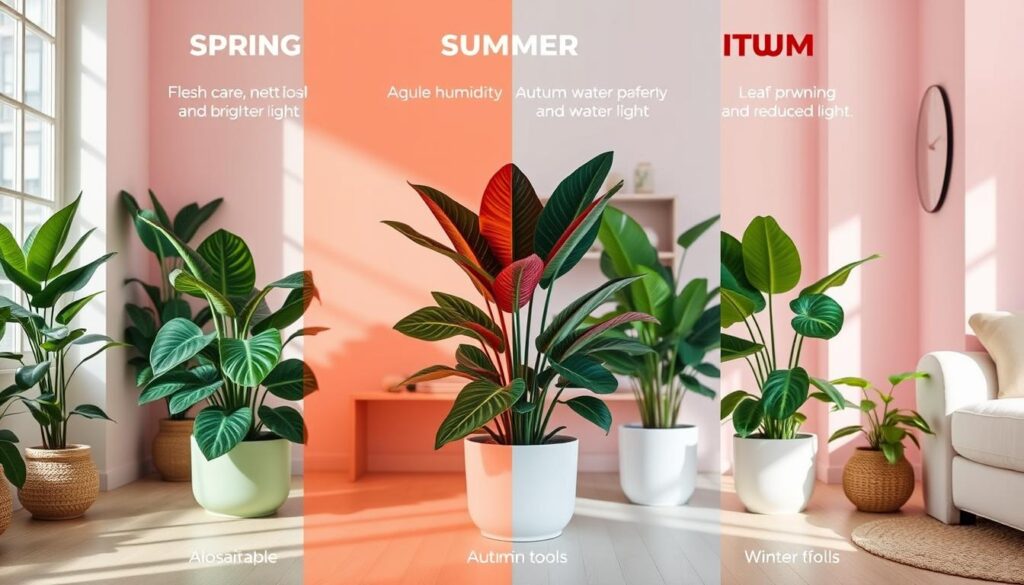
Creating a Humid Environment
To keep your Alocasia happy, creating a humid environment is key. You can use humidifiers or make your own humidity solutions. This helps your plant grow well and look great.
Using a humidifier is a good way to create a humid environment. These devices add moisture to the air. This keeps your Alocasia healthy. For more tips, check out trusted houseplant guides.
Or, you can try a DIY solution. Place your plant on a tray with water and pebbles. As the water evaporates, it makes the air around your plant humid. This is easy and won’t cost much.
By creating a humid environment, your Alocasia will do well. Keep an eye on the humidity and change your methods if needed. This will help your plant thrive.
Troubleshooting Care Issues
When you care for your Alocasia, you might face some common problems. Troubleshooting care issues is key to saving your plant and stopping future troubles. One big issue is when leaves turn yellow, often from too much water. To fix this, make sure the soil dries out a bit before watering again.
Root rot is another problem, caused by bad drainage and wet soil. Make sure your pot has holes for water to drain. Also, change your Alocasia’s pot every 12-18 months. If you see mushy stems or a bad smell, use fungicide and cut off the bad parts.
Being quick to solve problems helps your Alocasia do well. Always check on your plant and change how you care for it if needed. With the right care, your Alocasia can get better and keep growing strong.
Final Thoughts on Alocasia Care
Caring for an Alocasia plant is rewarding. It needs the right light, water, humidity, and food. This makes its leaves lush and tropical.
With patience and the right steps, you’ll enjoy Alocasia’s beauty. It adds unique charm to any home.
Considering Alocasia for Your Home
Are you drawn to Alocasia’s striking leaves and exotic look? Adding one to your home is a great idea. They do well in different lights and care.
They’re perfect for living rooms, bedrooms, or offices. Just remember to meet their care needs for them to thrive.
Encouragement for New Plant Owners
New to plant care? Don’t worry about Alocasia being finicky. With the right help, you can grow these plants well.
Start small and watch your plant. Adjust as needed. Seeing your Alocasia grow is rewarding.
Enjoy the journey and the vibrant foliage. It can turn any space into a personal oasis.
FAQ
What is Alocasia?
What are some popular Alocasia varieties?
What are the light requirements for Alocasia plants?
What are the ideal temperature and humidity levels for Alocasia?
What type of soil is best for Alocasia?
How often should I water my Alocasia?
What are the signs of overwatering or underwatering Alocasia?
What type of fertilizer should I use for Alocasia?
How do I know when to repot my Alocasia?
What are some common pests and diseases that affect Alocasia?
How do I prune my Alocasia plant?
How can I propagate my Alocasia plant?
Other Resources:
If you want to checl out other Humidity Loving Plants check out our articele: 10 Gorgeous Houseplants That Thrive in Humidity.
If you enjoy gardening in all forms check out Michelle’s YouTube Channel for all things plants HERE!


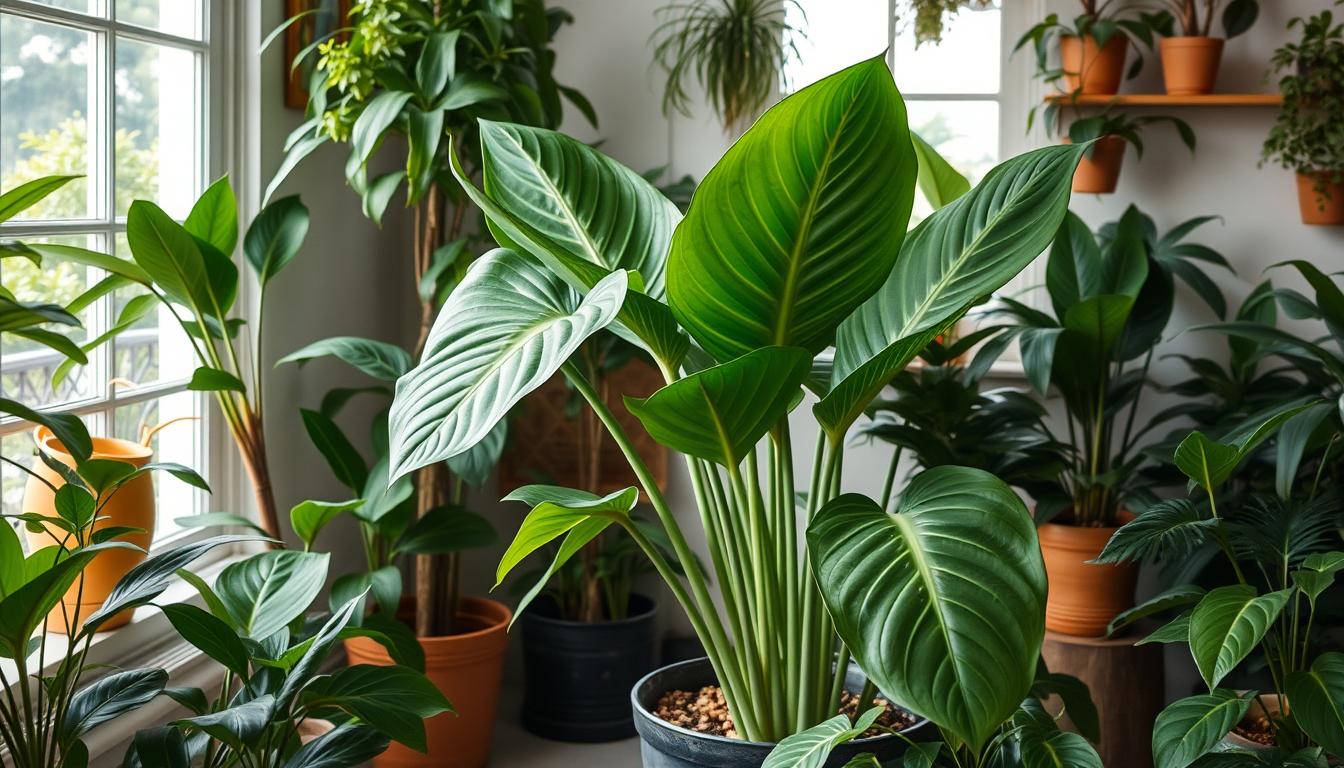
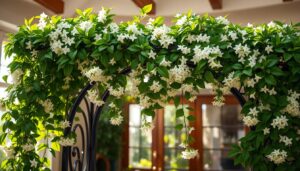

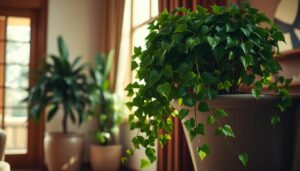
Pingback: 10 Gorgeous Houseplants That Thrive in Humidity - Trusted House Plant Guide